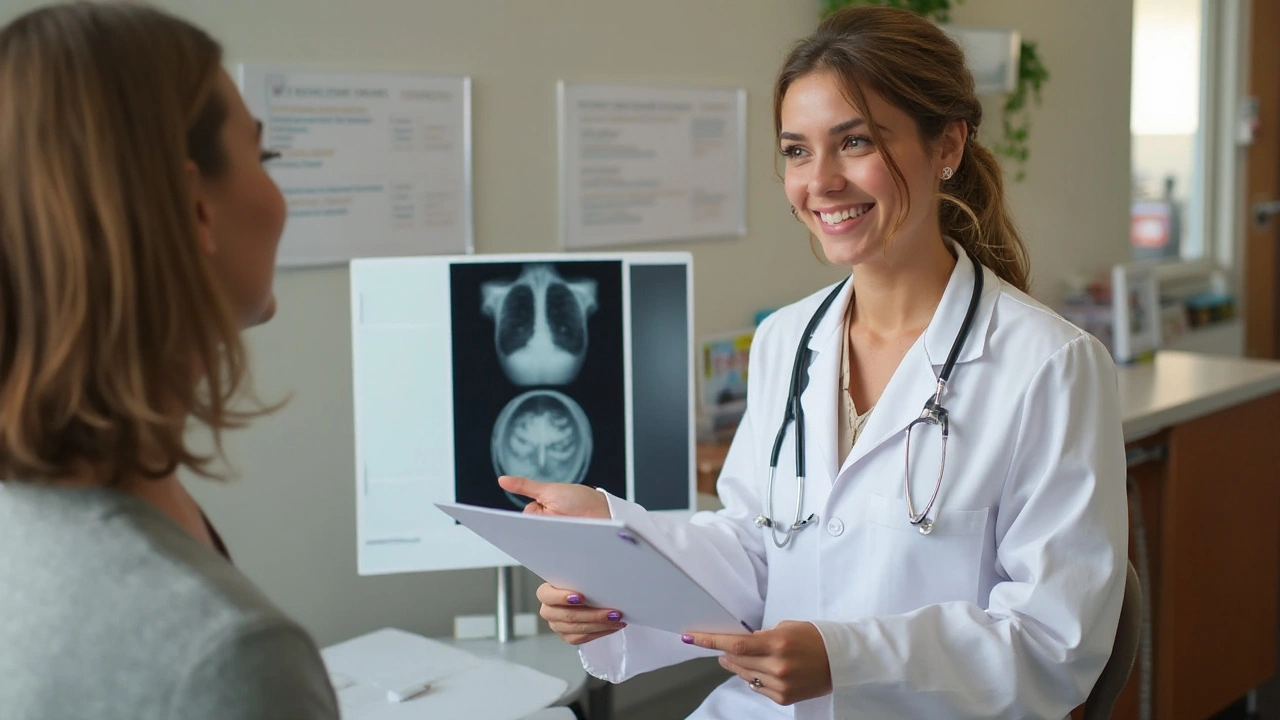Receiving a breast disease diagnosis is a moment that can throw you off balance emotionally and mentally. But understanding what lies ahead can make a world of difference in how you manage your condition and your feelings. Knowing what to expect will help you feel more in control, and help you make decisions that are best for your health.
Types of Breast Diseases
When we talk about breast diseases, a lot of people immediately think of breast cancer. While breast cancer is undoubtedly a major concern, there's a spectrum of other breast conditions that can affect one's health. Some are benign (non-cancerous), but understanding them is essential to managing your overall breast health.
First on the list is Fibroadenomas, which are solid, non-cancerous breast lumps most commonly found in young women. They feel firm, smooth, rubbery, or hard and have a well-defined shape. These lumps often move easily under the skin when touched and are typically painless, but sometimes they can cause discomfort.
Another condition to look out for is Fibrocystic Breast Changes. This encompasses breast pain, cysts, and non-cancerous lumps. It's extremely common and could affect up to 50% of women at some point. The symptoms can intensify with hormonal changes during menstrual cycles, making the breasts feel lumpy or rope-like.
Breast cysts are another non-cancerous condition. These fluid-filled sacs can be simple or complex, and they can vary in size. Simple cysts are filled with fluid and don’t need treatment unless they are painful. On the other hand, complex cysts may need further evaluation. According to the National Breast Cancer Foundation, “up to 25% of women aged 30 to 50 develop breast cysts.”
Beth Y. Karlan, MD, a renowned gynecologic oncologist, notes, “Knowledge about your particular type of breast lump is crucial for tracking changes and deciding whether further medical evaluation is necessary.”Then there is Mastitis, an infection of the breast tissue that results in breast pain, swelling, warmth, and redness. It’s most common among breastfeeding women. Treatment often involves antibiotics, and continuing to breastfeed is usually recommended since it helps clear the infection.
Ductal Carcinoma In Situ (DCIS) is another type of breast disease, though it's a non-invasive form of breast cancer. In DCIS, the cells lining the milk ducts have become cancerous, but they have not spread into surrounding breast tissue. It’s considered the earliest form of breast cancer and is highly treatable if detected early. The American Cancer Society highlights the importance of regular screenings for early detection.
Papillomas are small wart-like growths in the lining of the mammary duct near the nipple. They can cause nipple discharge, and while they are not usually cancerous, they might sometimes need to be removed via surgery.
Lastly, Hyperplasia is a condition that involves the overgrowth of cells within the ducts or lobules of the breast. There are two types: usual hyperplasia and atypical hyperplasia. Atypical hyperplasia raises the risk of developing breast cancer, so it often requires closer monitoring and possibly preventative treatments.
Understanding these conditions can form a cornerstone of proactive breast health. By keeping track of any changes through regular self-exams and professional screenings, you're taking crucial steps to catch potential issues early. Don’t hesitate to consult healthcare providers for any new or unusual symptoms you notice.

Symptoms to Watch For
Noticing unusual changes in your breasts can be alarming, but it's essential to be aware of the symptoms that might indicate a breast disease. Recognizing these signs early on can greatly improve your chances of successful treatment. One common symptom is a lump or mass in the breast, which can be detected through self-exams or during routine check-ups. It's important to note that not all lumps are cancerous, but they do warrant further investigation.
Besides lumps, keep an eye out for any changes in the skin texture of your breast. This can include dimpling, puckering, or the orange-peel appearance known as peau d’orange. Such changes can sometimes indicate an underlying issue that needs medical attention. Additionally, be attentive to any unusual nipple discharge, especially if it's bloody or has a foul odor. This could be a sign of an infection or other serious condition.
Another symptom to watch for is unexplained pain in the breast or nipple, which is not related to your menstrual cycle. While breast pain can arise from various causes, persistent or severe pain should always be evaluated by a healthcare professional. Swelling in all or part of the breast, even if no distinct lump is felt, can also be indicative of a problem. Sometimes, this swelling can extend to the lymph nodes under the arm or around the collarbone, which might suggest that the disease has spread.
Changes in the appearance of the nipples should not be ignored, either. Any inversion, flattening, or turning sideways of the nipple can be a symptom of breast disease. Keep an eye out for any redness, scaliness, or thickening of the nipple or breast skin, as these could be indicators of serious conditions, including inflammatory breast cancer.
Regular breast self-exams and awareness of your body’s norm are crucial. “Understanding your breast health means regularly monitoring for changes and bringing any concerns to your doctor,” advises Dr. Jane Smith, a renowned oncologist. Making note of any changes and tracking them over time can provide valuable information to your healthcare provider. It’s also a good practice to schedule routine mammograms as recommended by your doctor. Early detection through these screenings can significantly improve treatment outcomes.

Diagnosis Process
Getting diagnosed with a breast disease involves a series of steps aimed at accurately identifying the condition. This typically begins with a self-exam or a routine checkup where an abnormality may be discovered. If something unusual is found, your doctor will take steps to dig deeper.
The first step is usually a clinical breast exam conducted by a healthcare professional. They will manually check for lumps or abnormalities that you might have missed. If anything feels off, you'll likely be referred for imaging tests like a mammogram or an ultrasound. A mammogram uses X-rays to capture detailed images of the breast and can highlight areas that require more scrutiny.
In some cases, especially if you are younger or have dense breasts, an ultrasound might be used. This technology employs sound waves to create images of the inside of your breast, offering a different perspective that can sometimes be clearer in certain tissue types. If these imaging tests raise concern, your doctor might recommend an MRI for a more detailed look.
If the imaging finds something suspicious, the next step is usually a biopsy. This is a minor procedure where a small sample of the abnormal tissue is removed and examined under a microscope. The type of biopsy you undergo can vary. A needle biopsy is the most common and involves using a thin needle to take a sample. If a larger piece of tissue is needed, a surgical biopsy may be performed.
"Early detection of breast disease increases the odds of successful treatment. It's essential for patients to understand the process and stick to screening schedules." - Dr. Susan Love
Once the biopsy is done, the waiting period for the results can be challenging. Pathologists analyze the tissue to determine if it is benign or malignant, and the results usually take about a week. The findings will not only reveal whether you have a breast disease but also the type and stage of the condition, crucial data that will guide your treatment options.
After confirming a diagnosis, several other tests might be needed to better understand the stage and spread of the disease. These can include blood tests, bone scans, or even PET scans. The objective is to gather as much information as possible to tailor the treatment plan to your specific needs.
During this process, it's vital to keep an open line of communication with your medical team. Don't hesitate to ask questions, seek second opinions, or get clarification on anything you don't understand. Your healthcare providers are there to support you and help you navigate through this challenging time. Understanding each step can empower you, making the journey a bit easier to manage.

Treatment Options
When dealing with a breast disease diagnosis, understanding the full range of treatment options can bring some clarity and reassurance. The appropriate treatment depends on the type of breast disease, its stage, and the patient’s overall health. For some, surgery might be the primary treatment. This could mean a lumpectomy, which involves removing only the tumor and a small margin of surrounding tissue, or a mastectomy, where all breast tissue is removed. Advances in surgical techniques mean that many patients today can retain a more natural breast shape after surgery.
Another common treatment is radiation therapy. This approach uses high-energy rays to target and kill cancer cells. Radiation can be particularly effective in ensuring that any remaining cancer cells post-surgery are adequately dealt with. It's usually painless, though it may cause some fatigue and skin discomfort that often resembles sunburn. Patients generally undergo this treatment five times a week for several weeks, making it a commitment but a worthwhile one for many.
Then there is chemotherapy, often simply referred to as 'chemo'. This treatment uses powerful drugs to combat the disease. The drugs can be taken orally or injected into a vein, and they work by entering the bloodstream and attacking fast-growing cells. Unfortunately, chemo also affects other fast-growing cells in the body, like those in hair follicles and the digestive tract, leading to hair loss, nausea, and fatigue. But it's worth noting that chemo is a fighter, tackling cancer on a cellular level even after visible tumors are gone.
As Dr. Susan Love states, 'Chemotherapy is like using a sledgehammer to kill a weed in your yard. It's strong and broad, aiming to eradicate any hidden cancer cells, but it comes with side effects.'
Hormone Therapy
Some women might benefit from hormone therapy, especially if their cancer is hormone receptor-positive. This means the cancer cells grow in response to estrogen or progesterone. Medications like tamoxifen work by blocking these hormones, effectively starling the cancer and preventing its growth. This treatment can last for years and comes with its set of side effects, such as menopausal symptoms, but it significantly reduces the risk of recurrence in hormone-sensitive cancers.
Immunotherapy is one of the newer kids on the block. While still under extensive research, it has shown promise in helping the body's immune system recognize and attack cancer cells. Immunotherapy might be combined with other treatments to improve its effectiveness, and it is tailored to the specific genetic makeup of the cancer, making it a highly personalized form of treatment.
Targeted Therapy
Targeted therapy zeroes in on specific molecules within cancer cells. Drugs like trastuzumab are used to target the HER2 protein in some breast cancers. By focusing on these unique characteristics, targeted therapies can work more precisely than traditional chemotherapy, often with fewer side effects. They are particularly exciting because of their potential to shut down cancer’s growth mechanisms without harming surrounding healthy tissues.
While these treatments aim to tackle breast disease head-on, patients often find that complementary therapies like physical therapy, dietary changes, and stress reduction techniques provide added support. Activities like yoga, meditation, and acupuncture can help manage symptoms and improve quality of life during treatment.
Breast health care teams typically consist of a multidisciplinary group of professionals, including surgeons, oncologists, radiologists, and nurses. These experts come together to create a comprehensive and personalized treatment plan, ensuring that every aspect of the patient’s health is looked after. Navigating through these treatment options may seem daunting at first, but with the right support and information, patients can make empowered decisions for their health and well-being.





September 11, 2024 AT 11:36 AM
Fibroadenomas are often overdiagnosed in young women due to routine imaging. Many resolve spontaneously without intervention. The key is consistent monitoring, not immediate excision. Evidence-based guidelines support watchful waiting in asymptomatic cases under 30.
September 12, 2024 AT 08:56 AM
Let’s be real-no one tells you how emotionally draining the waiting period is after a biopsy. That week feels like a lifetime. I cried over spilled coffee because I was terrified the results would change everything. You don’t need a degree to feel that kind of fear.
September 12, 2024 AT 23:19 PM
It’s critical to recognize that DCIS is not invasive carcinoma-it’s a precursor lesion with variable biological potential. The term ‘cancer’ induces disproportionate panic. Current oncology paradigms are shifting toward active surveillance for low-grade DCIS, especially in older patients with comorbidities. Multidisciplinary tumor boards now routinely weigh quality-of-life metrics against overtreatment risks. Hormonal modulation via SERMs may be preferable to surgical ablation in select cohorts. Patient autonomy must be central to decision-making, not fear-driven urgency.
September 13, 2024 AT 00:47 AM
Why do women panic over lumps? I’ve seen too many get surgeries for nothing. Just eat less sugar and stop stressing. Your boobs aren’t that fragile.
September 13, 2024 AT 04:01 AM
why do people even talk about mastectomies like its normal?? its so wrong to cut off a women's breast... god will judge u for this. i would never do that even if i had cancer. god heals!